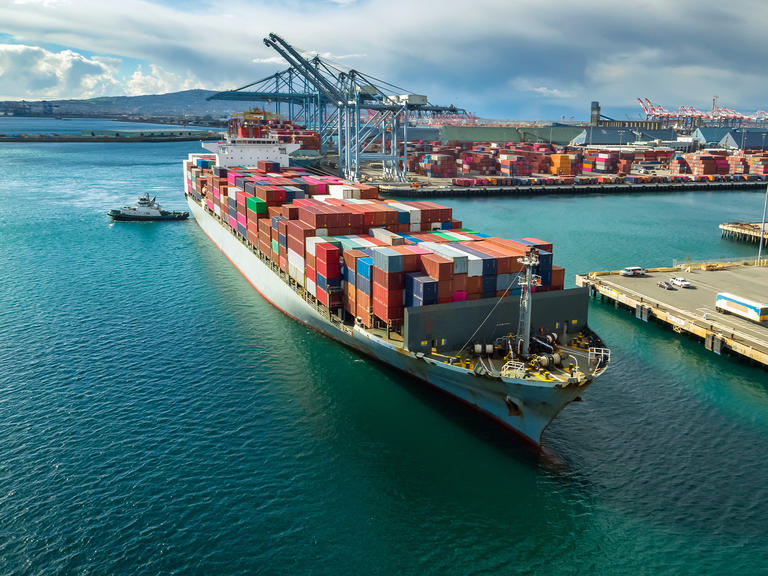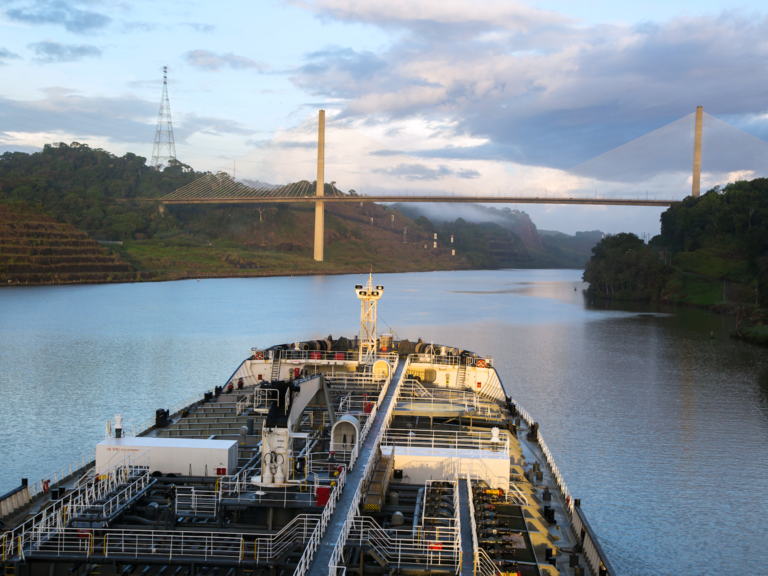Navigating shipping disruption with location technology

Ocean shipping is the backbone of global trade. A vital supply chain cog for a multitude of industries. How can location tech help avoid disruption?
Over the past few decades, growth in the shipping transportation sector has been phenomenal. Between 1990 and 2021, the volume of cargo transported by ship has almost tripled, from four to nearly 11 billion tons. It’s now estimated that 80% of goods are transported by ship.
Why shipping? For one very simple reason: “Sea freight is so cheap. That’s why everyone uses it,” said Ryan Wiggin, an industry analyst at ABI Research.
Keeping things shipshape
But what happens when there’s disruption at sea? From weather to accidents, it’s often impossible to predict until it’s too late.
Remember the ship that blocked the Suez Canal in 2021? It held up nearly US$60 billion in global trade and took a week to resolve.
Trade routes such as the Suez Canal are strategically important as they shortcut the journey between East and West. More than 17,000 ships go through the Suez each year, representing 12% of global trade and carrying US$1 trillion of goods. Disruption can turn it into a bottleneck.
Another vital trade route, the Panama Canal, links the Atlantic and Pacific oceans dramatically shortcutting the journey from Asia to the Americas and Europe. But its future could be under threat with the recent news that it is running out of water, with levels at their second lowest point in 110 years.
Disruptions such as these on major trade routes can have severe consequences. Especially for industries such as automotive that use just-in-time supply chains that depend on network reliability.

The current water levels in the Panama Canal are the second lowest recorded in the past 110 years.
Fueling the problem
Nils Haupt, Senior Director of Corporate Communications at Hapag-Lloyd AG, told BBC Radio 4's Today program that disruption in the Suez Canal, for example, “means going from Singapore to northern Europe will take approximately 12 days longer. If we go to the east Mediterranean, it will take 18 days longer. And to the east coast of the US, one week longer.”
Cost, of course, is the key concern. “Not only do we need more fuel, but we are also speeding up to save some time, and speeding up also costs additional fuel,” added Haupt.
As Haupt described it, shipping is about flow. Getting those empty containers from the port back to the factories to reload and reship. Delays compound and throw the cycle out of sync, with ships and containers in the wrong places at the wrong times.
“A lot of companies are realizing the need not just for visibility, but also better control of their network and planning in advance of these disruptions,” said Wiggin. “So, running scenarios and simulations to say, 'if we see disruption at a particular bottleneck in the supply chain, what can we do to minimize the impact?'”
Because that’s the thing with disruption – you can’t avoid it. It’s going to happen. But you can mitigate it through analysis.
Finding your sea legs |
| According to Wiggin, there are four key steps businesses can take to mitigate risk and vulnerabilities in their supply chains. |
| Transport and stock visibility: establishing visibility of transport arrangements and understanding where the stock is at every step of the journey, which can be as granular as you want it to be. |
| Infrastructure visibility: greater understanding of where the stock is passing through — for example, ports — with real-time visibility of backlogs and disruption. |
| Advanced analytics: for more proactive strategies. “Rather than just hoping your stock gets there and then worrying when something goes wrong, actually planning for that in advance through a lot of fancy solutions that are coming out,” added Wiggin. |
| Taking control: leveraging solutions like supply chain control towers where you have the visibility and can then implement steps with the stakeholders to change things and put plans in place for when disruption does occur. |
Agility and flexibility are key, added Wiggin, allowing businesses to be able to adapt at short notice when disruption occurs. But agility and flexibility don't happen by chance. “Being agile and flexible comes down to the preparation that you put in place,” he said. “You can't just be agile and flexible; you have to put the steps in place that allow you to be agile when disruption occurs.
“That goes back to assessing what your network looks like and understanding where the bottlenecks could be. And putting plans in place before anything even happens, so when it does you have already assessed what to do and have those plans in place.”
Our latest "On The Move” report, a survey of 900 people working in transportation and logistics, reveals that full, end-to-end supply chain visibility is hard to achieve. Consistent across all countries surveyed, T&L professionals indicate ocean freight is the mode of transportation providing the least amount of real-time visibility.
Giving disruption the heave-ho
The starting block for improved supply chain visibility and agility is location technology, according to Wiggin: “Location technology is the backbone for everything else you do. Ultimately if you know where your stock is, that’s the basis for developing all of these strategies and plans that allow you to become more resilient and agile.”
Insight and analysis – the key to preparation
Fail to prepare, prepare to fail might be a tired cliché, but when it comes to tracking your assets, preparation is everything. “For disruption, you need to prepare before it happens,” said Tomas Robenek, Industry Solutions Manager at HERE. “Because once it happens, there’s not much you can do unless you were prepared for it. It also allows you to learn from your operations and mistakes. If you know that’s where a lot of delays happen, then you should feed that back and proactively address those delays.”
For that, location data is king. But making sense of that data, which can come from multiple sources, is what HERE’s map-making and location services excel at. “We take the real world and turn it into a map,” said Robenek.
To do that HERE aggregates data from a lot of different sources: satellite imagery, vehicle data, probe data, weather data, and data from municipalities. It can then process and make sense of this, turning it into a digital visualization. “We can do the same for logistics: take data from the vessel, data from the port (such as current truck congestion in the area) with routing and rerouting built in and layers showing disruption such as weather and traffic.”
It means logistics professionals can see in real time where the backlogs are, how their ETAs are affected, and how the problem could propagate and cause problems along the supply chain. “You could even run a scenario analysis and understand the delta between your original plan and your backup plan, based on your KPIs, such as cost, or service level agreement,” said Robenek.
The insights don’t stop once your cargo has left the ship either. PSA International, which operates the Port of Singapore, has launched OptETruck in conjunction with HERE. This innovative truck fleet management system using HERE Tour Planning and Location Services decreases transit and waiting times, minimizes empty loads, improves drivers’ well-being and reduces carbon emissions. Companies that use OptETruck have reported a 50% reduction in empty runs, helping to reduce as much as 10 million kilos of carbon emissions a year.
Have your say
Sign up for our newsletter
Why sign up:
- Latest offers and discounts
- Tailored content delivered weekly
- Exclusive events
- One click to unsubscribe


